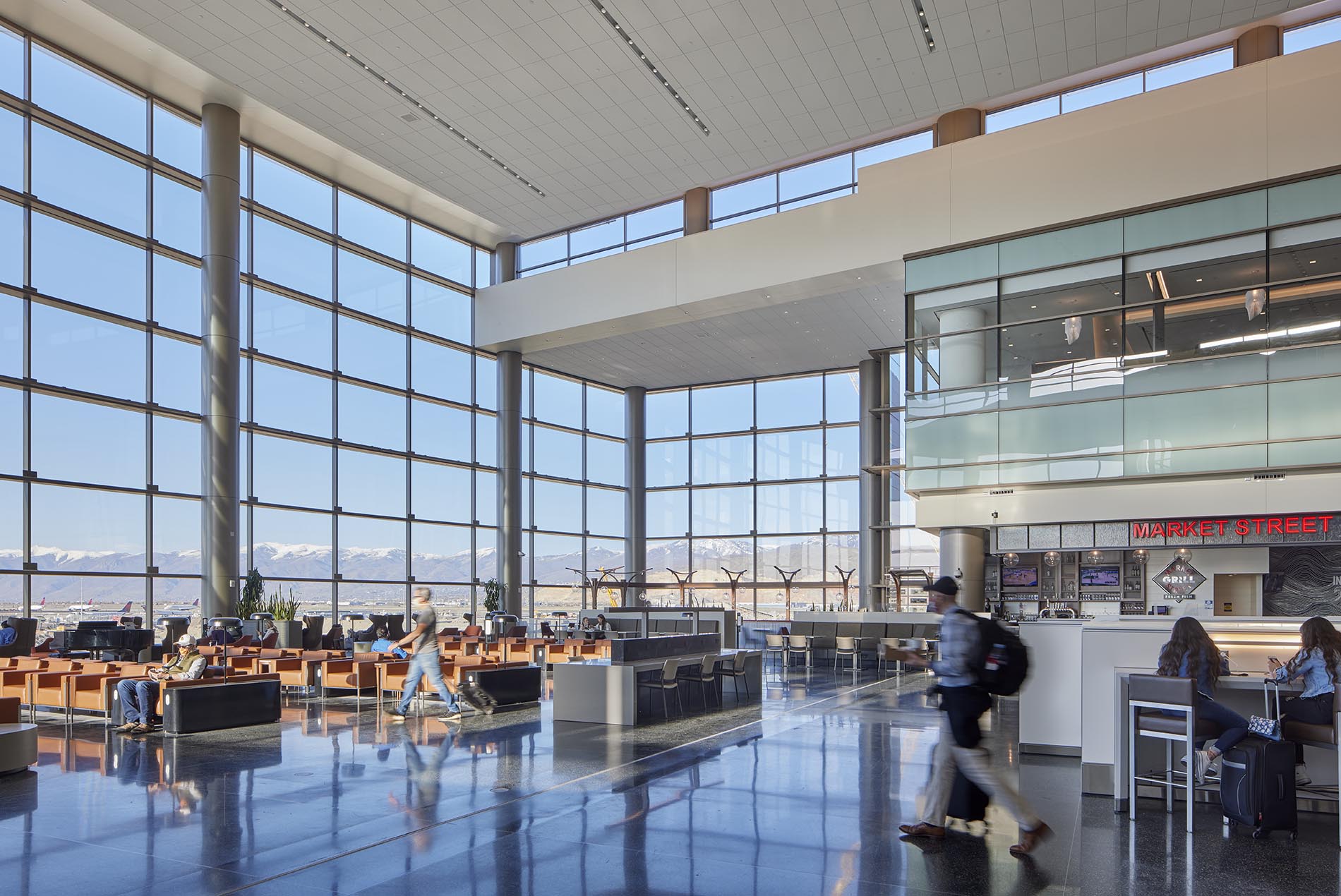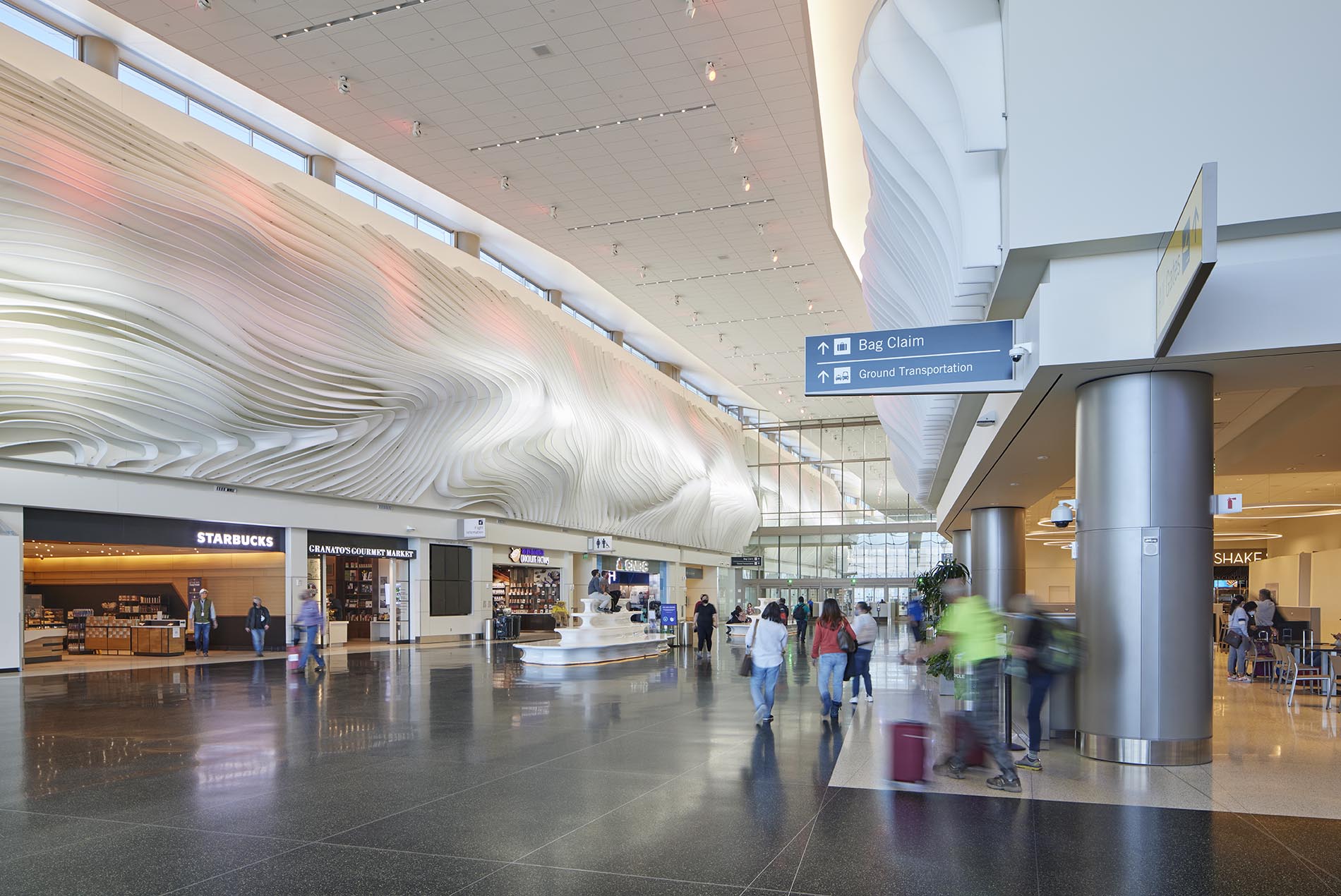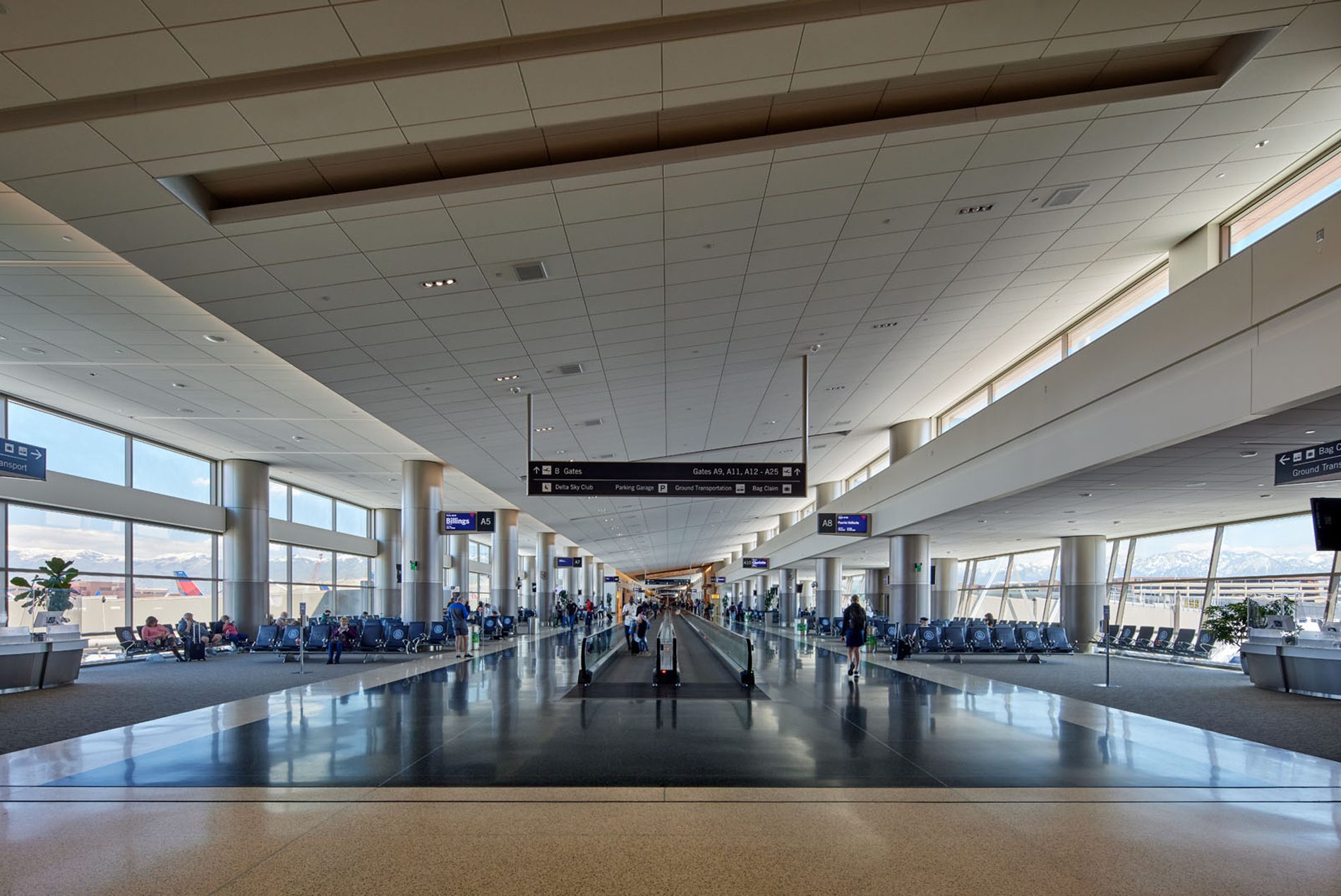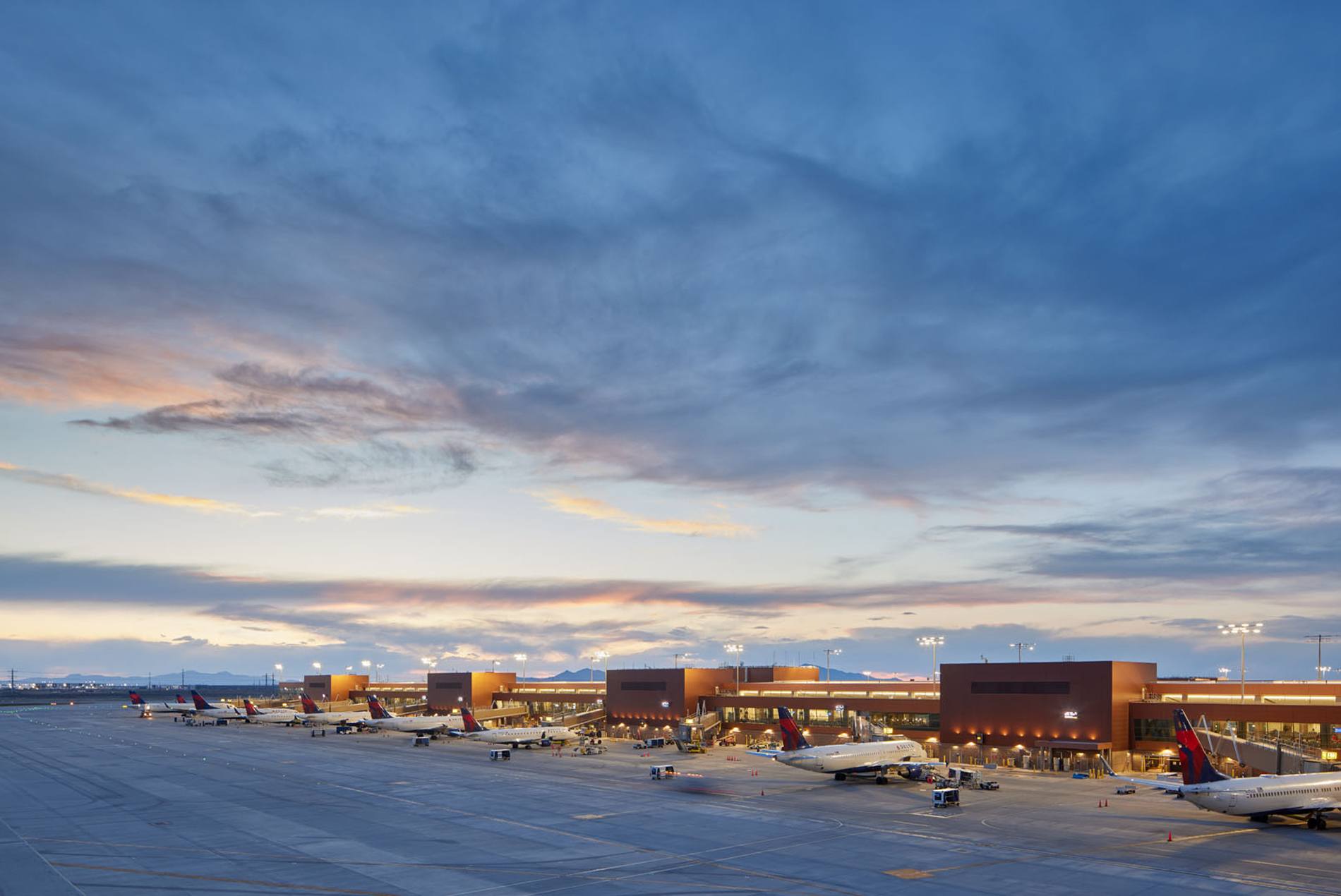In a recent LinkedIn Live, HOK’s Matt Needham, Alan Bright and Claire Moore joined Salt Lake City International Airport’s Mike Williams to discuss SLC’s Terminal Redevelopment Program, recognized as the first new U.S. hub airport built in the 21st century.
Known as the New SLC, it is the largest public works project in Utah’s history, replacing three aging facilities with a highly efficient, sustainable and beautiful airport. The LinkedIn Live panel discussion explored the new Salt Lake City International Airport’s design and how it provides flexibility and growth for the airport. Watch the full discussion below or read key highlights from the talk.
1. Build a collaborative, integrative team with a clear design vision.
Highly complex projects like airport terminals require close collaboration from the start. Bright shared how he engaged with SLC stakeholders during visioning sessions to brainstorm key elements for the new airport. Passenger experience was a priority, along with showcasing Utah’s natural landscape and culture, bringing back the wonder of flight, and creating a clear, single-level layout. “The design provides clarity and simplicity in movement and servicing passengers and really celebrates Utah and its natural beauty,” said Bright, HOK’s design principal on the project.
“The design provides clarity and simplicity in movement and servicing passengers and really celebrates Utah and its natural beauty,” said Bright, HOK’s design principal on the project.
2. Create a sense of place.
Salt Lake City International Airport distinctly represents Utah. The terminal’s central atrium (known as the Canyon) features an undulating art sculpture by artist Gordon Huether that symbolizes Utah’s slot canyons. Red, orange and brown lights illuminated on the wall sculpture mimic the canyons’ natural colors. Floor-to-ceiling windows in the space provide breathtaking views of the Wasatch Mountain Range. Utah’s welcoming spirit is also woven into the design. Needham and Bright described how the team decided to incorporate a greeting room for families to reunite with loved ones. It includes a fireplace, art museum and windows overlooking the airfield. A world map lets family members share where they have traveled.
Utah’s welcoming spirit is also woven into the design. Needham and Bright described how the team decided to incorporate a greeting room for families to reunite with loved ones. It includes a fireplace, art museum and windows overlooking the airfield. A world map lets family members share where they have traveled.
“We were just starting the design, meeting in the old airport, and would hear cheering outside near the old baggage claim. It could be five people or 20 people—it was interesting,” shared Needham, HOK’s lead aviation planner on the project. “Missionaries [from the LDS Church] were coming back and seeing their families for the first time in two years. The greeting room was a direct response to celebrate that.”
3. Maximize return on investment through design.
Design impacts an airport’s operational and maintenance costs, financial health, environmental stewardship and occupant well-being. SLC’s layout allows for growth and maximizes the airport’s ROI. Needham highlighted how the underground passenger tunnels that connect the concourses support flexibility and growth.
“This is designed for quick and efficient connections for hub operations,” said Needham. “It’s an investment that has been paying off because SLC has seen an incredible rise in passenger traffic last year.” Widened concourses at SLC comfortably accommodate a growing number of travelers. This design consideration has more than doubled the amount of restaurant and retail space in the new terminal, leading to increased revenue streams.
Widened concourses at SLC comfortably accommodate a growing number of travelers. This design consideration has more than doubled the amount of restaurant and retail space in the new terminal, leading to increased revenue streams.
4. Prioritize resilient and sustainable design.
Due to its proximity to the Wasatch Fault, SLC needed to be resilient and seismically safe against earthquakes. Moore discussed how the team tackled the structural design of 29 separate buildings to withstand earthquakes and extreme weather conditions. “That was an interesting challenge based on the number of buildings that are part of the overall development,” said Moore, HOK’s lead structural engineer on the project. “The airport itself is comprised of what looks like one large terminal and concourse plus the tunnels that connect to Concourse B. But each one of those buildings is structurally separate. This allows for thermal movements for the buildings in this very hot and cold climate.”
“That was an interesting challenge based on the number of buildings that are part of the overall development,” said Moore, HOK’s lead structural engineer on the project. “The airport itself is comprised of what looks like one large terminal and concourse plus the tunnels that connect to Concourse B. But each one of those buildings is structurally separate. This allows for thermal movements for the buildings in this very hot and cold climate.”
Energy savings were also key to the design process. Air systems, high-performance glazing, energy-efficient mechanical systems and more were carefully chosen to reduce SLC’s energy usage.
5. Be adaptable during the project phasing process.
The New SLC’s phased approach ensured that a certain number of gates were always open, enabling the airport to continue operations and support revenue growth—a critical factor for the airport and Delta Air Lines, which uses SLC as its hub.
During the pandemic, the project team capitalized on an opportunity to accelerate the construction timeline for the four-phase development. Williams shared how the stakeholders agreed to move all operations into the hardstand terminal completed during Phase I in the fall of 2020 and demolish the rest of the old airport simultaneously.
“It created some pain points up front, but this process made the project phasing much simpler,” said Williams, SLC’s program director on the project. “We delivered Phase I for the west side of both concourses and then immediately took down the old airport, which allowed us to phase our way through the east side of concourse A and the central tunnel and the east side of concourse B. We’ll now be delivering the second half of the airport in October of this year, October of next year, and October of the following year.”
